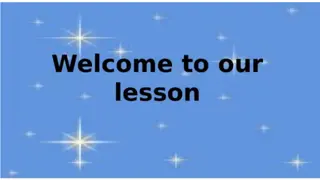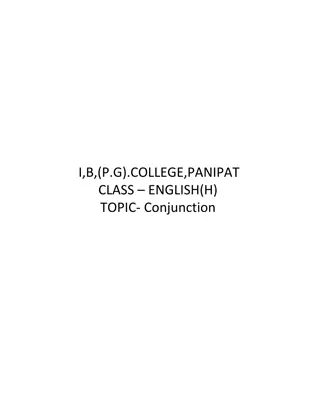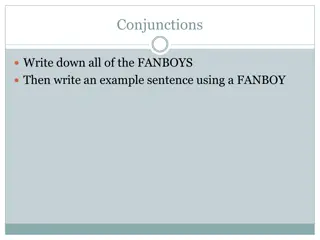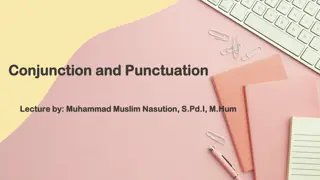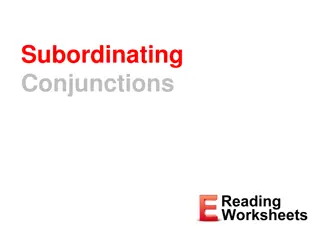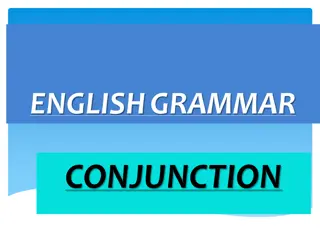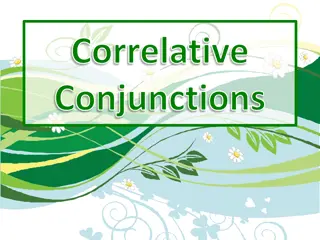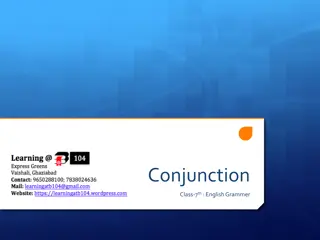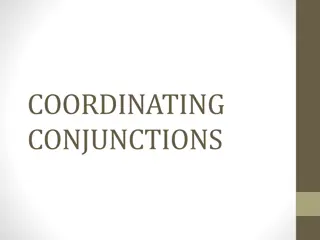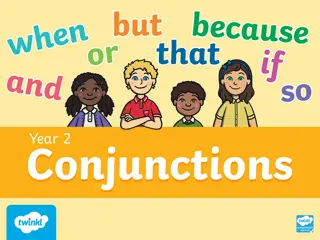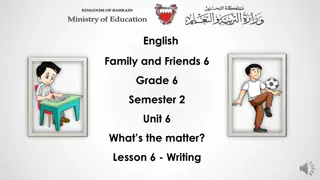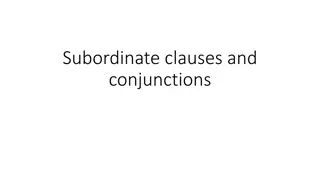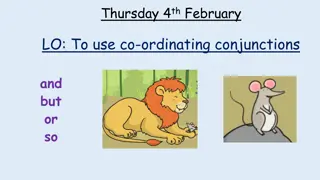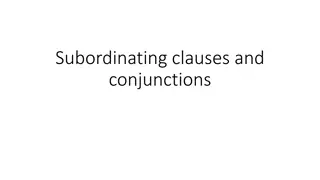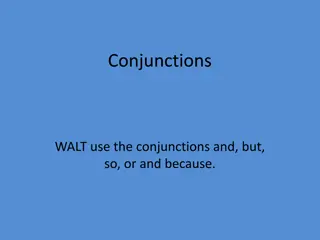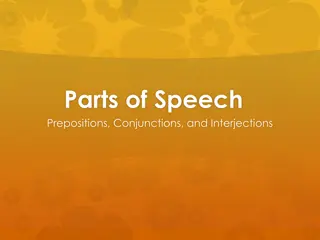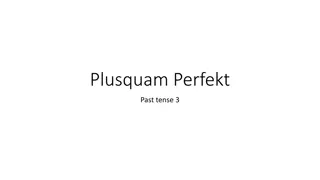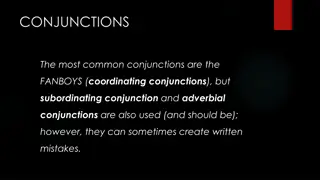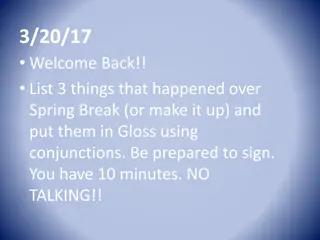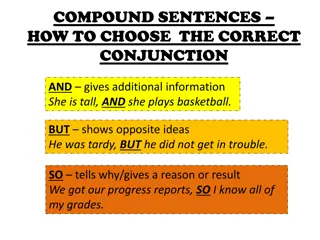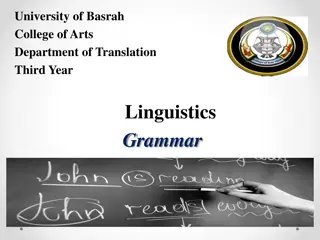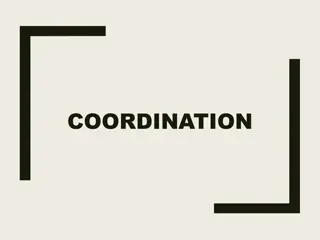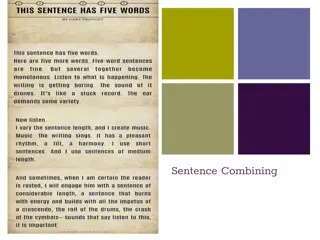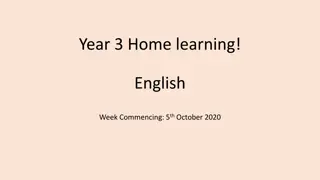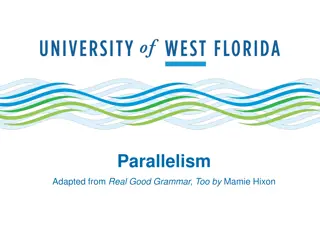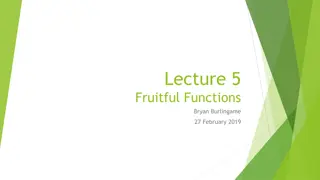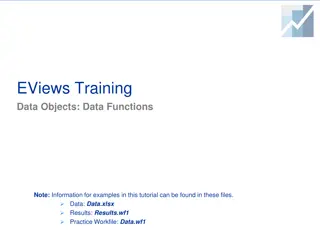Understanding Conjunctions and Their Functions
Learn about conjunctions, including how they link words, phrases, and clauses together. Discover the different types of conjunctions, such as coordinating and subordinating conjunctions, and understand their roles in connecting various elements of a sentence. Explore examples and grasp the importance of conjunctions in forming cohesive and coherent sentences.
Download Presentation

Please find below an Image/Link to download the presentation.
The content on the website is provided AS IS for your information and personal use only. It may not be sold, licensed, or shared on other websites without obtaining consent from the author. Download presentation by click this link. If you encounter any issues during the download, it is possible that the publisher has removed the file from their server.
E N D
Presentation Transcript
Conjunctions link words, phrases, and/or clauses together. Bonnie and Clyde In rain and wind He jumped and screamed. Over the river and through the woods Do you want coffee or tea? Over or under He wanted to leave but couldn t. He wanted to leave, so he did.
Consider the different items that are linked together: 2 nouns: Bonnie and Clyde In rain and wind Do you want coffee or tea? 2 verbs: He jumped and screamed. He wanted to leave but couldn t. 2 prepositional phrases: Over the river and through the woods 2 adverbs: Over or under 2 clauses (sentences): He wanted to leave, so he did.
There are 7 conjunctions that can link together anything: phrases, clauses, nouns, verbs, etc. and, but, or, nor, for, so, yet The popular order these days is for, and, nor, but, or, yet, so because the initials spell fanboys.
Remember that, as always, some of these can function as some other part of speech : You should listen to your father, for he is a wise man. conjunction that joins 2 clauses (sentences) This gift is for you. preposition He is sick, so he can t go to the party. conjunction that joins 2 clauses (sentences) He is so sick. adverb A conjunction links two parts of speech, phrases, etc., so when you see a fanboys, you just need to see if it links two of those. If not, you need to determine what other part of speech it is.
For, and, nor, but, or, yet, & so are called COORDINATING conjunctions. They link things that are equal. For example, in the sentence John and Susan are going to church neither John nor Susan is more important than the other. In John laughed and cried neither laughed nor cried is more important than the other .
Theres another set of conjunctions: subordinating conjunctions. There are far more than seven of them, and they can t link just anything; they can only link clauses. We haven t talked about clauses yet, because we re going through the 8 parts of speech before doing anything else. To understand clauses, you need to understand subjects & verbs, but we haven t discussed subjects yet. Chances are great that you know what a subject is, but if you don t, you need to leave this slide show until we discuss clauses and then come back
Lets take a quick look at subjects & verbs: Dogs bark. Drunks vomit. Janet cheers. Babies cry. Alex shouts. John plays. In all of the above sentences, the first word, which is a noun, is the subject. It is doing an action. The second word is that action. So all of the sentences above consist of a subject & a verb. A clause, very simply, is a group of words containing a subject & a verb. A sentence is therefore a clause, because a sentence always has at least one subject & one verb, but a clause isn t necessarily a sentence. Let s combine two of the sentences above: Alex shouts, and Janet cheers. We ve combined the two sentences with a coordinating conjunction ( fanboys ). So what we have is a single sentence with two clauses (subject + verb and subject + verb). Because we ve used a coordinating conjunction, the two clauses are equally important, & both are called INDEPENDENT clauses.
Now lets combine those same two sentences with a word that is NOT a coordinating conjunction: Alex shouts while Janet cheers. While is not a coordinating conjunction; it is a subordinating conjunction. The two clauses are no longer equally important. Because while is a subordinating conjunction, the clause that comes after it is subordinate to (less important than) the other clause.
A subordinating conjunction is a word that precedes a clause (subject + verb, remember) & ties it to another clause: I cried because I was sad. She eats whenever she is hungry. We read before we go to bed. If you want more money, you need a job. The subordinating conjunctions are in red; the subjects are in blue; the verbs are in green. You ll notice that the less important clause can come at the end (as it does in the first three sentences) or at the beginning (as it does in the last sentence). It s always the subject + verb that comes after the subordinating conjunction that is the less important (called subordinate or dependent ) clause.
Following are some common (and not-so-common) subordinating conjunctions, but don t consider the list complete. supposing where because than whereas before that wherever but that though whether if though after since when although so that whenever as which in order that till while lest unless who no matter until why how what even though As always, many of these words can function as something besides a subordinating conjunction. You ran into before in the slide show on prepositions. Let s look at that one again.
I was here before. I was here before the movie. I was here before the movie started. In the first sentence, before is an adverb, answering the question when. In the second sentence, it s a preposition because it s followed by a noun. In the third, it s a subordinating conjunction because it s followed by a subject + verb. By definition, a subordinating conjunction has to precede a subject + verb. Just watch out for the question words: why, where, when, how. If they re asking a question, they re adverbs, not conjunctions: When are you leaving? When is an adverb. (Easier to see when you put the question in statement form: You are leaving when. ) I ll leave when I m ready. When is a conjunction; it subordinates the subject + verb I + (a)m.
Have you ever heard someone talk about his subordinates at work? Those are people who are under him. If someone is a subordinate, that means there s someone in a position above him. By the same token, a subordinating conjunction makes a clause subordinate to another clause. As we noted, the clause with the subordinating conjunction is less important than the other clause. The point here is that you can t have just a clause with a subordinating conjunction. That clause has to be subordinate to another one. *When I leave. We say this in conversation, but it s not a correct sentence. It s a fragment, incomplete because it needs a clause to which it can be subordinate. When I leave, you can sell my car. NOW it s a complete, correct sentence, because when I leave is subordinate to you can sell my car.
Remember: its only a subordinating conjunction if it s followed by a subject + verb. In summary, there are 2 types of conjunctions: coordinating( fanboys ), which make words/phrases/etc. equal when they link them, & subordinating, which can link only clauses & which make one clause subordinate to another.
Identify the conjunctions in the following paragraph. You need to indicate whether each conjunction is COORDINATING or SUBORDINATING. I looked for some novel excerpts to give you for this exercise, but clauses are complicated, and you need something simple for clause identification at this point. You need to look for subject + verb to see if they are independent or if they have a subordinating conjunction in front of them. Coordinating conjunctions are fairly easy, but subordinating conjunctions are much harder because there are so many of them and because you have to find subject + verb. The lesson on clauses is quite a bit further down the road, and after you ve done that lesson, if you come back here, you ll find this exercise very simple. For now I want to keep this as straightforward as I can. Until you have a little more experience with phrases and clauses, I want to keep your attention focused on how the parts of speech work.
Coordinating conjunctions are red, & subordinating conjunctions are green. I looked for some novel excerpts to give you for this exercise, but clauses are complicated, and you need something simple for clause identification at this point. You need to look for subject+ verb to see if they are independent or if they have a subordinating conjunction in front of them. Coordinating conjunctions are fairly easy, but subordinating conjunctions are much harder because there are so many of them and because you have to find subject + verb. The lesson on clauses is quite a bit further down the road, and after you ve done that lesson, if you come back here, you ll find this exercise very simple. For now I want to keep this as straightforward as I can. Until you have a little more experience with phrases and clauses, I want to keep your attention focused on how the parts of speech work.
Exercises http://www.education.com/study-help/article/conjunctions_answer1/ (Do just the top exercise, 1-10. Answers are at the bottom.) http://www.perfectyourenglish.com/grammar/identifying-conjunctions.htm (Answers are at the bottom.) http://www.ucl.ac.uk/internet-grammar/conjunct/ex1.htm http://www.grammar-monster.com/lessons/conjunctions.htm Exercise written for this slide show


